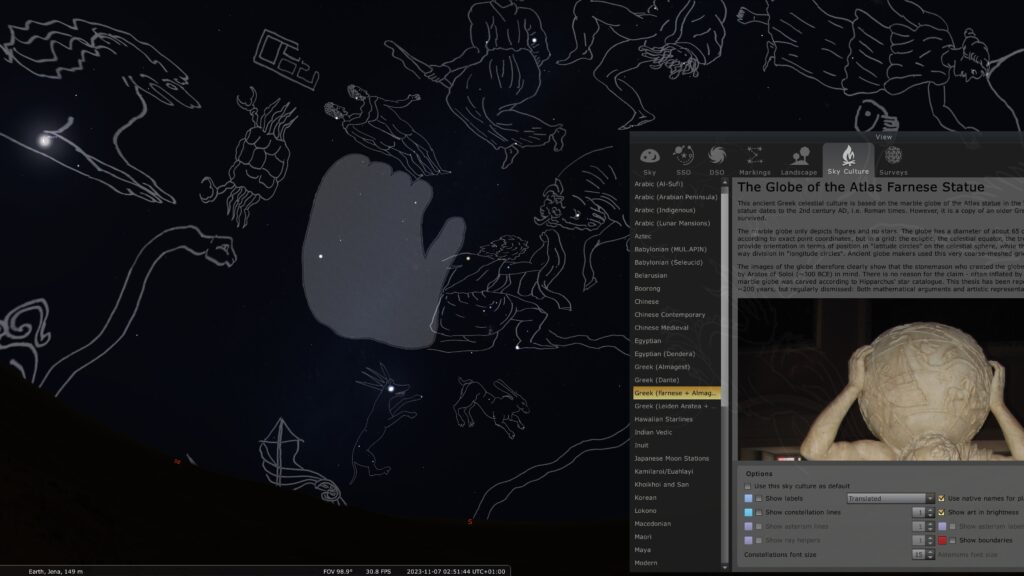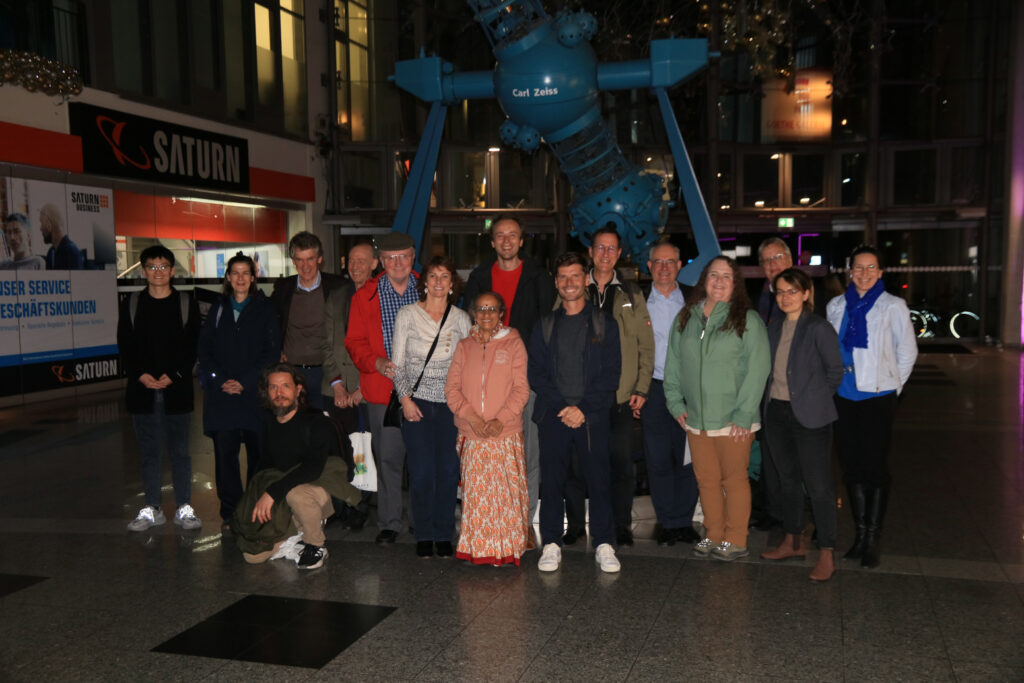The Artificial Sky (IAU & digital planetarium)
BLOG: Uhura Uraniae

The Working Group Star Names (WGSN) and the Stellarium team met in Jena from 1 to 3 November to think together about ways of managing cultural data. Astronomy is a science that works across faculties: Astrophysics has admittedly been one of the pioneering sciences for large databases and other repositories since the 1970s and the beginning of the space era or space telescope era. However, as soon as we go beyond astrophysics and include astronomy (i.e. all the other branches of astro-science), we leave the realm of established repositories and have to create new ones. The free and open-source software Stellarium allows contributions from researchers (whether ethnology, anthropology, history of science, cultural studies, philology…) and this has already been used many times. The repository currently has around 40 to 50 “sky cultures”, i.e. sets of representations of constellations, their names and descriptions. A “sky culture” consists of names for constellations, line figures and/or images of constellations, sometimes also names of individual stars, definitely a description (where does this culture come from, where is it located on Earth and how was the one depicted in Stellarium developed) and a licence.

The Working Group Star Names (WGSN) of the International Astronomical Union (IAU) was founded in 2015/6, started its work in 2016 and has been endeavouring to increase the diversity of star names ever since. The first step in this group’s work was therefore to determine the names of stars that are already in use. The aim is to ensure that several spellings of a star name do not exist side by side in astrophysical articles in order to a) simplify keyword searches and b) simplify the reading of papers, e.g. should it be “Wega” or “Vega”, “Atair” or “Altair”, … all variants are equally valid transliterations from Arabic, but the idea was initially to standardise these spellings internationally (at least for research papers).
Occasionally, the general public is asked to suggest names in so called NameExoWorlds campaigns. Then and only then, i.e. only in the context of these naming campaigns, suggestions are accepted – in the most recent naming campaign last year, for example, with the explicit rule that no names of individuals may be suggested. However, earlier campaigns did not have this rule. The public campaigns only target stars that are not visible to the naked eye and where planets are known. Being able to address exoplanets and their host stars by name rather than “phone numbers” is effectively the trigger for these latest IAU activities.
New culture as expression of respect
After the known star names (such as Vega) were officially written down in the first step (2016-2021), the question now is what strategies will be used to assign further star names. Personally, I think we should limit the naming of stars to historical and indigenous names of stars and constellations and not use names of people: comets or moon craters are named after people.
Die Sterne, die begehrt man nicht,
man freut sich ihrer Pracht
und mit Entzücken blickt man auf
in jeder heiteren Nacht.
[verses by Joh. W. Goethe]
In addition, constellations have been invented in all cultures to symbolise general interpersonal values (of love, friendship, respect, sacrifice, recognition). In my opinion, such universal values and the legendary figures that embody them are perfectly suited to naming stars.
Since the IAU wants to represent all people(s) equally and respect all cultures and was founded in 1919 (after the First World War) explicitly to overcome political differences through scientific co-operation, it is important to us to also put names of other cultures in the sky than just the “traditional” Arabic, Greek and Latin ones. Australian and Polynesian names were therefore also placed in the sky in the early years of the group’s work. However, this did not always meet with unreserved approval in the respective culture of origin. Sometimes cultural names are subject to restrictions in their own culture, e.g. that they may only be pronounced by women or only by men. Such names cannot (logically) be made official names.
So the questions about the naming of stars by the IAU are:
- Where do we get the names from that we make official in the sky?
- What criteria do we use to select from these in order to achieve the widest possible equal distribution and to respect the cultures of origin?
My approach when I joined the WGSN was (and still is) that we could use the Stellarium repository because it is fed with data by the cultures themselves or respectful researchers or even members of the indigenous communities. If something is in Stellarium, then it must have a licence (necessary for upload) that allows global use (not always commercial use), i.e. the original culture is respected in any case. The only disadvantage is that the data set is not (and never will be) complete. However, we don’t have to name all 8000 stars at once. The problem is similar with lunar craters, for example, and they can still find a nameless one if necessary if an important astronomer is suggested.

Discussion
The question that keeps coming up is whether the IAU’s approach itself is overreaching. Of course, the idea of artificially inventing star names and borrowing them from other cultures is a kind of “diversity with a sledgehammer” and, of course, it is again the overarching community of professional astronomy that assigns the names. You can read this as hegemony or as an attempt to counteract it. There are voices against the use of Aboriginal names (which logically use animals that only exist in Australia, e.g. the emu) for stars in Greek or Babylonian constellations … and there are voices that explicitly demand this.
Other major points of discussion at such highly interdisciplinary meetings are terms (such as constellation, asterism, etc., which are often used differently by amateur astronomers than in the specialised sciences). I think that if we succeed in drawing up a common definition that corresponds to all the specialist disciplines, this would simplify the scientific language for the coming decades/centuries – not all amateur astronomers have to go along with this; the main thing is that the specialist world comes to an agreement, as this simplifies interdisciplinary work.
The last word is far from spoken, but it was a fascinating meeting. I met many of these colleagues, with whom I have been working for years, for the first time. I hope that after further remote working, we will come together again in about one to two years and look back on this first meeting as a wonderful kick-off.

(translated with DEEPL.com)

